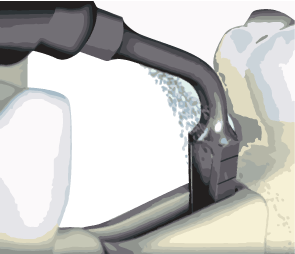Ridge splitting and bone expansion osteotomy with guided bone regeneration for placement of dental implant in aesthetic zone
In certain cases where teeth are lost due to trauma or poor oral hygiene, a catabolic process involving gradual resorption of the bone tissue is engaged as time progresses. Diminishing of the buco-palatal ridge dimension, forms an inadequate aesthetic zone for implant placement, requiring an additional procedure to receive an optimal area for further surgical intervention allowing an implant fixture placement.
Multi-dimensional assessment of the available bone is the most important factor necessary for a well-planned treatment, ensuring longevity and function of the implant-supported prosthesis. The minimum implant height in an ideal bone density situation for predictable success is 10 mm, when available width is defined as the distance between the buccal and the lingual plates, measured at the crest.
Each 1 mm increase in diameter increases the surface area by about 20–30%, therefore, increasing diameter effectively, decreases crestal stress. Thus, the implant diameter is much more critical than its length.
Many techniques and materials have been introduced to successfully manipulate the bone, to reach an aesthetically and functionally acceptable alveolar ridge for successful implant placement. Ridge-widening techniques are used as a form of pre-prosthetic ridge plasty for providing support to partial/full dentures placement.
Ridge splitting: is a technique-sensitive procedure that creates a self-space making defect in the atrophied alveolar crests, used to augment the atrophic maxilla and mandible before the implant placement.
Bone expansion technique maintains the existing soft bone by pushing the buccal bony plates of the residual ridge laterally with minimal trauma. This technique takes advantage of the softer bone quality found in Types III and IV maxillary bone by relocating the alveolar bone rather than losing the precious bone by drilling.
Bone is a biologically privileged tissue in that it has the capacity to undergo regeneration as a part of repair process. As one or the other techniques are applied on the narrow alveolar ridge, in both cases we will obtain a space, made in the middle of the alveolar ridge, following the buccal plates separation. GBR procedure is unavoidable, as this newly formed space must be filled by a bone graft material and covered by a resorbable or non-resorbable (depending on the case) membrane to allow a new bone tissue formation in the augmented alveolar ridge, both in immediate implant placement or a two stage procedure where the alveolar ridge is first augmented and given adequate healing time for a future dental fixture placement.
DSI offers a wide range of tools, bone surgery kits, GBR kits encompassing a broad spectrum of techniques and clinical options, in order to cover all the aspects of the procedures from start to finish, and suit best the clinician’s needs:
Bone Expander Full Kit


Bone Expander Drill Kit


Bone Spreader Kit


Never Lose Bone Collector Drill Kit


Ridge Split Chisel Set


Bone Alignment Burs

Lindemann Drills for Bone Surgery




